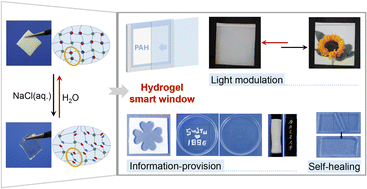A salt-triggered multifunctional smart window derived from a dynamic polyampholyte hydrogel†
Abstract
Hydrogel smart windows are promising candidates for the automatic modulation of light transmittance through thermo-, humidity-, and electrochromic mechanisms. However, thermo- and humidity-triggered hydrogel smart windows are usually passively controlled and are not convenient for achieving active actuation; electrochromic windows require complex assembly and energy input. In addition, existing hydrogel smart windows are susceptible to physical damage, which may significantly shorten their working life. Herein, a salt-triggered polyampholyte hydrogel (PAH) is developed as a novel smart window with active and facile actuation as well as self-healing ability. The dynamic ionic bonds in PAH can reversibly disassociate and reform in alternate aqueous sodium chloride solution (NaCl(aq.)) and H2O, accounting for the reversible transparency-shifting and efficient modulation of light transmittance. PAH also enables patterning through precisely localized treatment with NaCl(aq.), which is useful for one-time information input/storage. Information encryption can be further realized by embedding PAH into an inherently transparent hydrogel or pasting it on an information carrier; the visibility of information is in line with the transparency-shifting of PAH. Moreover, the dynamic ionic bonds can endow the PAH-derived hydrogel smart window with self-healing and automatic damage-repairing abilities without sacrificing light modulation. Thus, salt-triggered PAH provides a new idea for designing actively actuating hydrogel smart windows with multifunctionality.

- This article is part of the themed collections: Materials Horizons 2022 Most Popular Articles and 2023 Materials Horizons Lunar New Year collection


 Please wait while we load your content...
Please wait while we load your content...